Unlock The Sorrel Mule With A Pencil
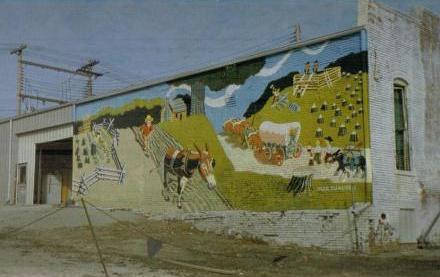
The "Land Of Opportunity" mural
measures 35 feet wide and 20 feet tall.
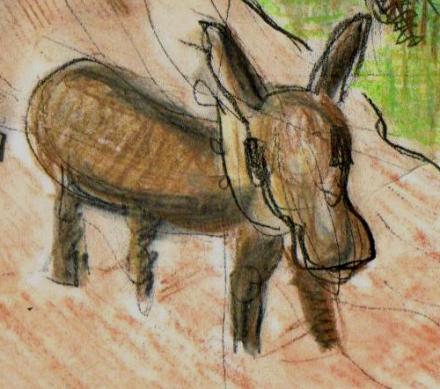
I remember my father telling me not to show this to anyone. How embarrassing.
My sketch of a mule looked more like a dog. This is where I started from.
A drawing with colored pencils on my desk at home.
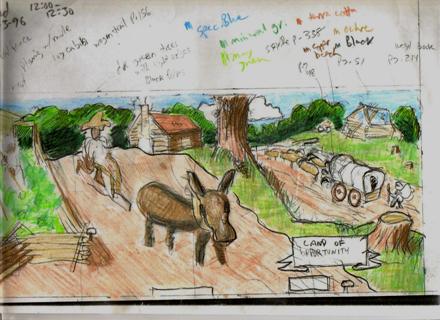
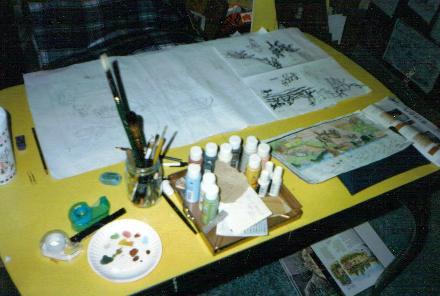
It is 1997 and owner Don Lock has given me permission to paint a mural from this
sketch on the south side of his property, the Lock Steel building,
located one block east of downtown Carrollton, near Virginia and Washington Streets.
This mural measures 35 feet wide and 20 feet tall. The most prominent image
is that of a farmer cutting a furrow behind a sorrel mule. Here are the stages
of that mule.
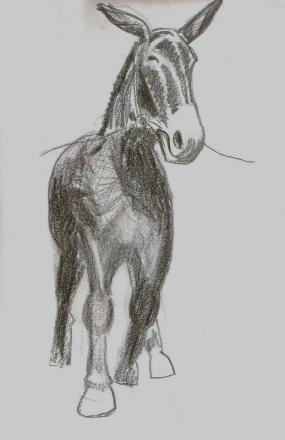 "How is a mule
different from a horse?" I asked
"How is a mule
different from a horse?" I askedmy wife native to Missouri. She told me about the bigger ears. Ultimately,
it would be a pencil that unlocked the Sorrel Mule.
At the City library I found black and white photos of mules at State Fairs.
There were frontal shots, the head, neck, chest, and front legs. And sideview
shots. I borrowed a photo from Bud Miles, who stood in the photo as a young lad,
holding the reins to the big mules.
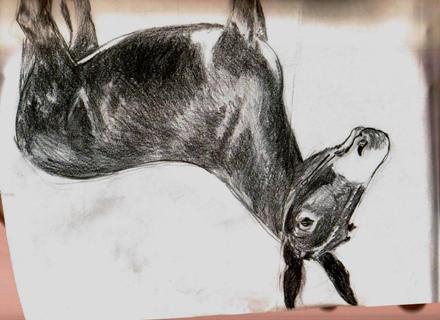
At my drawing table, I drew the mule right-side up and upside-down.
Often artists will work from an upside-down image as a way of focusing
on the lights and darks, without having to think about ears, noses, legs,
eyeballs.
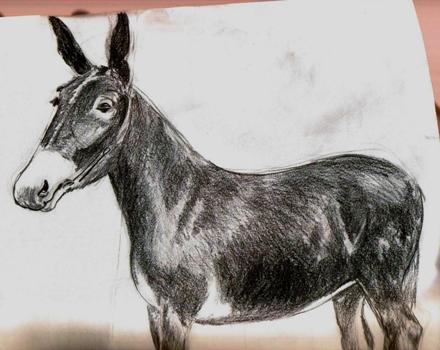 After several days of drawing,
After several days of drawing,my wife walked in to the drawing room and saw the mule drawing.
"That is a mule!" she declared. "You got it."
After I had this image, I had to re-work it so that it looked like the mule was
coming down a hill towards you, bu also so you could see its side as well.
I looked at how the artist Thomas Hart Benton did it in his lithographs.
I looked at book illustrations about harnesses for plows. I even went to
an Amish farm north of Carrollton to draw a one-mule plow. I thought a farmer
walked easily behind a plow. But I found out it would have been hard work,
because the ground was rough. It often had tree roots and rocks underground
that needed to be removed by hand. It took everything the farmer had to
steady the plow with his arm muscles. If you look closely at the mural you will
see the farmer pushing and gripping the plow handles.
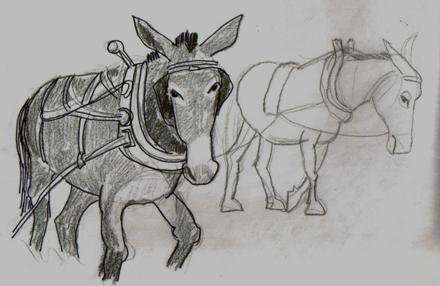
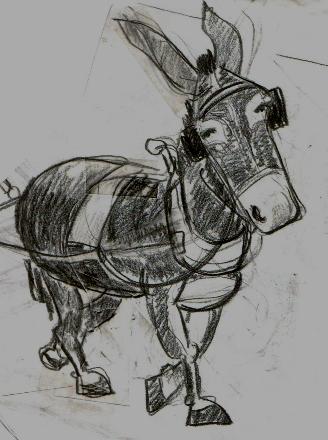
Once I had the mule coming toward the viewer, I figured out its coloring.
Again, I looked at book illustrations others had made, to understand the
rust color of a sorrel mule, and then how it might look with sunlight hitting one
side and the other side in shadow.
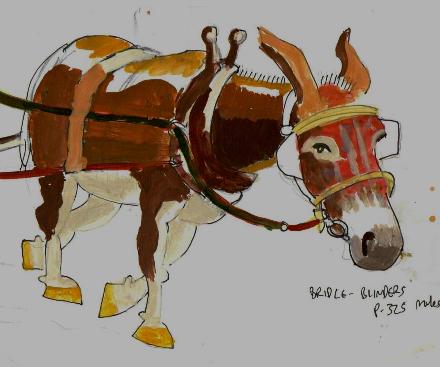
(See the notation scribbled beside the study? Bridles and blinders
page 325 from a resource book at the library.)
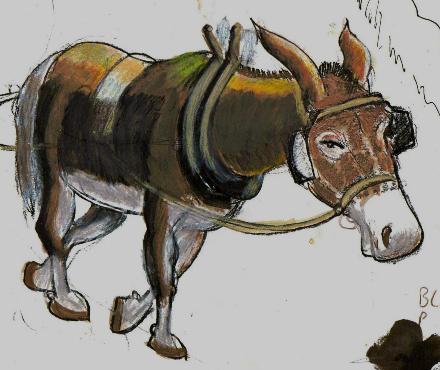 Using colored pencils
Using colored pencils to shade with, this is the final mule study I referred to when I painted the mural.
 To
put the mural image up on the
To
put the mural image up on theoutside wall, the wall needed to be scraped clean of loose paint chips, dirt, and
brick dust. Then, the whole wall was coated with an oil-based primer with a
sprayer, which was re-filled often. And that paint needed to go through a
strainer or grid, so that the paint could go easily through the sprayer.
After two coats of primer paint had dried, a scaffold was assembled, with a
step ladder on top and an overhead projector on top of that. The stepladder
had empty milk jugs filled with water slung on its rungs with bungee cords,
to weight down the ladder and make it stable. The scaffold was 30 or 40 feet
away from the wall. A long long ladder leaned against the wall. At night,
when it was dark, a transparency (like the mule above) was put on the
overhead projector which was pointed towards the wall. I climbed the long long
ladder up up up and traced that mule image onto the wall with a black magic marker.
I would reach as far as I could with my arms, then climb down the ladder,
lift the ladder with my arms, move the ladder over a bit, climb back up up up,
and draw the image so more with the marker, until the whole image was traced
on to the wall.
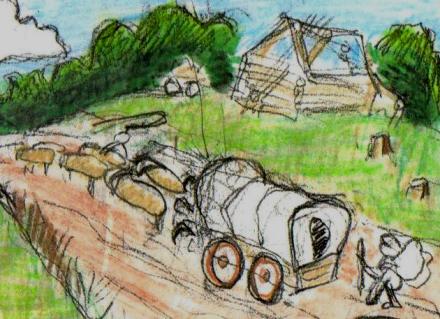 The mural was made up of MANY images.
The mural was made up of MANY images.This is the rough colored sketch of the wagon team and the house builders above.
Every image was studied and re-drawn from books at the library. The drawings
other illustrators had made helped me ALOT. I learned how to draw wagon wheels,
a team of oxen, tree stumps, the building of a log cabin, and how workers moved
the logs up into the house. Much much homework. Lots of drawing and re-drawing.
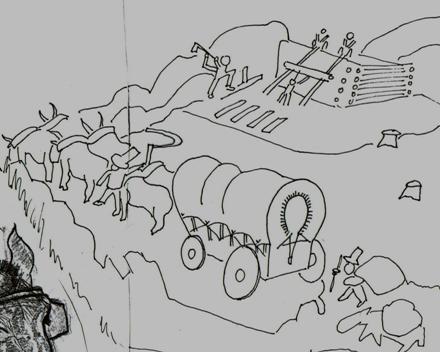 This is the "wagon team" transparency.
This is the "wagon team" transparency.This was put up on the overhead projector another night and drawn onto the
wall with a black marker. The man chopping wood in the picture came from a
painting I had found in a book. After all the images had been drawn on the wall,
I had to do detailed studies of each image. The farmer's face. The plow.
The garden vegetables. And where did I find vegetables to sketch?
 I
spent
time at the Amish farm sketching their garden.
I
spent
time at the Amish farm sketching their garden.Cabbage, beets, and onions have a certain shape and color. More homework to do.
Another book at the library had travelers
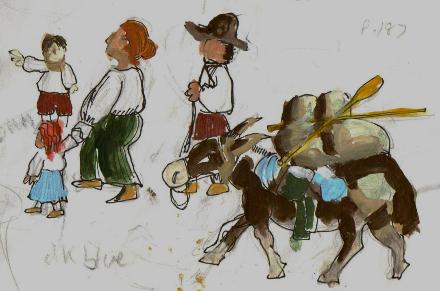
on foot. This is the color study I used to paint the foot travelers on the wall.
Hand-mixed oil-based enamel paint was used topaint the wall mural. Every color
was mixed from white, black, red, blue, and yellow. Local artist Curtis Bish explained
to me how it could be done. But there came that momment of truth when I poured
yellow into black hoping it would turn "green." Guess what? It DID turn green.
Mixed colors were poured into empty two liter pop bottles or empty milk jugs.
This wall mural had over 200 hours put into it. I began in August and finished
in December of 1997.
This mural says something about the city of Carrollton.
Land Of Opportunity.
My pencil would come in handy when I designed "classes" for the
Business College in Chillicothe.
Home
Sign up for email newsletter here